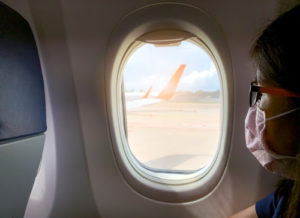According to leading international epidemiologists, the novel coronavirus (2019-nCoV) outbreaks that are at present overwhelmingly concentrated in China are likely to soon reach pandemic status, defined as an epidemic prevalent on two or more continents.

A 3D rendering of the novel coronavirus
According to media reports on 2 February, infectious disease specialists assess that 2019-nCov is behaving more like influenza than severe acute respiratory syndrome (SARS) or Middle East Respiratory Syndrome (MERS). Furthermore, Chinese scientists cited in a media report by state-run Xinhua news agency identified faecal-oral transmission as a possible additional vector. To date, the mortality rates for 2019-nCoV is around 2 per cent, against 10 per cent for SARS and 34 per cent for MERS. The risk from the present outbreaks are considered far higher in countries with un-or underdeveloped public health systems that those of more advanced economies.
Nevertheless, the first confirmed death from 2019-nCoV outside China emphasised the growing threat of contagion. On 2 February the Philippines Department of Health reported the death of a 44-year old male Chinese national who arrived in the country from Wuhan, the epicentre of the 2019-nCoV epidemic. The announcement came hours after local media reported that the country’s President Rodrigo Duterte was preparing to order a temporary travel ban on all visitors from China, including Hong Kong and Macau and regardless of nationality, entering the Philippines. At least 240,000 Filipinos live in Hong Kong, with thousands more in Macau.
The list of countries barring entry to all foreign nationals who had travelled to China continues to grow. The US, Australia, and New Zealand have all banned non-nationals from entry or transit if they have visited China in the preceding 14 days, the 2019-nCoV incubation period, with immediate effect.
Japan, South Korea, Indonesia and Russia have all imposed a range of entry restrictions on visitors from China.
The number of airlines suspending services to China also continues to rise, with the state airlines of Saudi Arabia and Oman ending flights on 2 February. Delta, United and American Airlines announced on Friday they are suspending all flights between the US and mainland China. Australia’s Qantas Airlines will stop all flights to China from 9 February to 29 March; flights to Hong Kong will continue as normal. Air New Zealand, Qatar Airlines, Philippine Airlines and Vietnam Airlines will also suspend service to China. Vietnam has halted almost all flights serving China and Taiwan. All flights into the US from China will only be permitted to land at a limited number of airports, including New York’s Kennedy Airport (JFK), Chicago’s O’Hare (ORD) and San Francisco International Airport (SFO).
The number of confirmed 2019-nCoV cases worldwide reached more than 17,000 on 3 February, with all but around 170 recorded in China. At least 360 people are known to have died from the virus in China as of 3 February, exceeding the deaths known to have been caused by SARS outbreaks in 2002-2003. Almost all the deaths were recorded in Hubei province, primarily Wuhan, the epicentre of the outbreak, although the actual toll is certain to be far higher. The death rate, at around 2 per cent of those to contract the virus, remains mainly confined to elderly males with pre-existing medical conditions.
Confirmed cases of 2019-nCoV outside China as of 1 February were reported in Japan (20), Thailand (19), Singapore (18), Hong Kong (15), Australia (12), South Korea (11), Germany, Taiwan (10), US (9), Malaysia (8), Macau (7), Vietnam (6), France (5) Canada, UAE (4), Britain, Russia, Italy, India (2), and Spain, Finland, Sweden, Nepal, Cambodia, Philippines, Sri Lanka (1). Numerous other potential cases are being investigated throughout the world.

Woman wearing a face mask in a departing plane
ANALYSIS
Despite the efforts of China’s health authorities there is no indication the outbreak is close to being contained. There are media reports from the epicentre Wuhan, a city of around nine million people, that the medical system is unable to cope with the ever increasing number of people infected with either the coronavirus or seasonal influenza and other illnesses.
The authorities in Hong Kong, under growing pressure to further restrict into the territory from China, have ordered the closure of all schools until 2 March. Some medical workers in the territory have said they will go on strike from 3 February unless the government closes the land border with mainland China, although frontline staff have said will continue to treat patients. The local administration is unlikely to introduce such a measure, not least because much of Hong Kong’s food is sourced from China.
Both Vietnam and Pakistan suspended and subsequently reinstated air travel via China. Thailand has so far not joined the ranks of countries that have implemented travel bans, despite mounting domestic pressure to do so. Such pressure is likely to compound existing dissatisfaction with the Thai government over issues including growing public health concerns over air pollution.
Bangkok, along with other governments is facing the choice of instituting travel bans and appeasing the public, or relinquishing substantial tourism revenues. Thai officials estimate that losses in tourism revenues from Chinese visitors over the Lunar New Year (24 January – 2 February) will amount to THB50 billion (USD1.6 bn).
Hong Kong, Japan, and Thailand are among the top destinations for Chinese tourists, and the coinciding of the outbreaks with the annual holiday – during which millions of Chinese citizens travel throughout Asia and beyond – will severely dent profits for tour operators and other businesses that benefit from the influx, including in the hospitality industry.
Japanese Prime Minister Shinzo Abe on 3 February said that his government will maintain communication with relevant stakeholders, including the World Health Organization (WHO) and the International Olympic Committee, to ensure that the 2019-nCoV outbreaks will not interfere with the Tokyo Olympic and Paralympic Games, scheduled for July 2019.
The announcement comes after Tokyo’s governor, Yuriko Koike, on 29 January said that failure to contain the spread of the disease could impact the event. The governor on 2 February announced that ‘thorough measures’ will be implemented to protect people from the disease. It also comes after the Games’ organisers had to combat the spread of misinformation that the events would be cancelled due to the outbreaks.
The outbreaks have had a pronounced impact on Taiwan. In addition to the desire to avoid tariffs imposed throughout the US-China trade war, they serve as a further motivator for Taiwanese firms in the mainland to relocate their operations to the island. At the same time, however, Taiwan’s inclusion in a recent WHO report on 2019-nCoV has resulted in the island being included in several travel bans involving mainland China. This is despite the fact that the island has a separate healthcare system and a far lower number of confirmed cases.

Commuters wearing breathing masks on the subway in Chongqing, China
RESPONSE
Companies operating in the Asia-Pacific region should assess what measures they may have to introduce in order to protect staff while maintaining operational continuity, including halting all travel to China, particularly Hubei province. Further measures include the evacuation of non-essential staff or suspension of operations pending further review. Assess the impact of outbreaks on supply chains and consider implementing contingency plans to minimise the risk of operational disruption.
Business travellers and companies should also monitor updates from domestic authorities, including aviation and customs agencies, regarding potential restrictions on trade and transport in Asia and elsewhere. Further, the immediate impact of additional airport medical checks on business travellers and staff may involve increased processing times due to physical and document screening.
Any personnel experiencing symptoms such as runny nose, cough, fever, headaches, shortness of breath, chills, and body aches should seek immediate medical attention. More information is available on the US Centers for Disease Control and Prevention website.
Travellers and staff should ensure they exercise suitable sanitary precautions, including regularly washing hands, in order to mitigate the risk of infection.
Source: A2 Global Risk



















